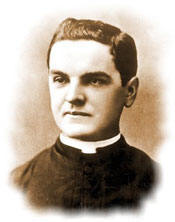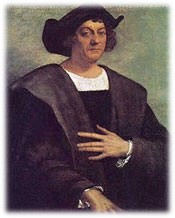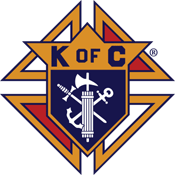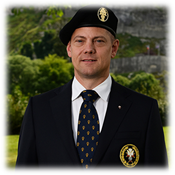

The Knights of Columbus is the world's
largest Catholic fraternal service organization. Founded
in the United States in 1882, it is named in honor of
Christopher Columbus.
There are more than 2 million members world wide as of 2019, in 16,000
councils, with nearly 300 councils on college campuses.
Membership is limited to "practical Catholic" men aged
18 or older.
Councils have been chartered in the United States,
Canada, Mexico, the Caribbean, Central America, the
Philippines, Guam, Saipan, Japan, Cuba, and most
recently in Poland.
A new era has begun for the Knights of Columbus:
A modern single, public exemplification ceremony can now be used to
welcome men to our ranks as full members of the Order.
The new ceremony combines the three ceremonies used in the past.
This issue takes an in-depth look at the new exemplification
0ceremony: what it is, why it’s changed and how you can run one.
Straightforward and easy to implement, the new
exemplification ceremony gives Catholic men the opportunity
to publicly commit to being Knights — ready to lead, serve,
protect and defend.
Knights of Columbus Insurance sells a portfolio of insurance
and annuities products to its members—an outgrowth of a
system of support instituted by Venerable Father J.
McGivney in 1882 when he founded the Knights to help
families in the event of the loss of a breadwinner.
The highly rated Fortune 1000 insurance company has a
force of 1,207 agents who are also Knights. Once the
company’s revenue is used to cover operational costs
and refunds (dividends) to our members, the remaining
profits are directed to charity.
Over the last business year, Knights of Columbus Insurance
issued $8.6 billion of new life insurance, provided $1
billion in benefits, including $441 million in death
benefits and $262 million in refunds to members.

The Knights of Columbus was founded by an
Irish-American Catholic priest, The Venerable
Father Michael J. McGivney in New Haven,
Connecticut. He gathered a group of men from St.
Mary's parish for an organizational meeting on
October 2, 1881 and the Order was incorporated
under the laws of the U.S. state of Connecticut
on March 29, 1882. Though the first councils
were all in that state, the Order spread
throughout New England and the United States in
subsequent years.
The primary motivation for the Order
was to be a mutual benefit society. As a parish priest
in an immigrant community, McGivney saw what could
happen to a family when the breadwinner died and wanted
to provide insurance to care for the widows and orphans
left behind. He himself had to temporarily leave his
seminary studies to care for his family when his father
died. In the late 19th century, Catholics were regularly
excluded from labor unions and other organizations that
provided social services.
In addition, Catholics were either
barred from many of the popular fraternal organizations,
or, as in the case of Freemasonry, forbidden from
joining by the Catholic Church itself. McGivney wished
to provide them an alternative. He also believed that
Catholicism and fraternalism were not incompatible and
wished to found a society that would encourage men to be
proud of their American-Catholic heritage.
McGivney traveled to Boston to examine the Massachusetts
Catholic Order of Foresters and to Brooklyn to learn
about the recently established Catholic Benevolent
League, both of which offered insurance benefits. He
found the latter to be lacking the excitement he thought
was needed if his organization were to compete with the
secret societies of the day. He expressed an interest in
establishing a New Haven Court of the Foresters, but the
charter of Massachusetts Foresters prevented them from
operating outside their Commonwealth. The committee of
St. Mary's parishioners McGivney had assembled then
decided to form a club that was entirely original.
McGivney had originally conceived of the name "Sons of
Columbus" but James T. Mullen, who would become the
first Supreme Knight, successfully suggested that
"Knights of Columbus" would better capture the
ritualistic nature of the new organization. The Order
was founded 10 years before the 400th anniversary of
Columbus' arrival in the New World and in a time of
renewed interest in him. Columbus was a hero to many
American Catholics, and the naming him as patron was
partly an attempt to bridge the division between the
Irish-Catholic founders of the Order and Catholic
immigrants of other nationalities living in Connecticut.

The Connecticut
Catholic ran an editorial in 1878 that
illustrated the esteem in which American
Catholics held Columbus. "As American Catholics
we do not know of anyone who more deserves our
grateful remembrance than the great and noble
man - the pious, zealous, faithful Catholic, the
enterprising navigator, and the large-hearted
and generous sailor: Christopher Columbus."
The Connecticut
Catholic ran an editorial in 1878 that
illustrated the esteem in which American
Catholics held Columbus. "As American Catholics
we do not know of anyone who more deserves our
grateful remembrance than the great and noble
man - the pious, zealous, faithful Catholic, the
enterprising navigator, and the large-hearted
and generous sailor: Christopher Columbus."
The name of Columbus was also
partially intended as a mild rebuke to Anglo-Saxon
Protestant leaders, who upheld the explorer (a Catholic
Genovese Italian working for Catholic Spain) as an
American hero, yet simultaneously sought to marginalize
recent Catholic immigrants. In taking Columbus as their
patron, they were sending the message that not only
could Catholics be full members of American society, but
were, in fact, instrumental in its foundation.
By the time of the first annual convention in 1884, the
Order was prospering. In the five councils throughout
Connecticut were 459 members. Groups from other states
were requesting information. The Charter of 1899
included four statements of purpose, including "to
promote such social and intellectual intercourse among
its members as shall be desirable and proper, and by
such lawful means as to them shall seem best." The new
charter showed members' desire to grow the organization
beyond a simple mutual benefit insurance society.
The original insurance system devised by McGivney gave a
deceased Knight's widow a $1,000 death benefit. Each
member was assessed $1 upon a death and when the number
of Knights grew beyond 1,000 the assessment decreased
according to the rate of increase. Each member,
regardless of age, was assessed equally. As a result,
younger, healthier members could expect to pay more over
the course of their lifetimes than those men who joined
when they were older. There was also a Sick Benefit
Deposit for members who fell ill and could not work.
Each sick Knight was entitled to draw up to $5 a week
for 13 weeks (roughly equivalent to $125.75 in 2009
dollars). If he remained sick after that the council to
which he belonged regulated the sum of money given to
him.
Today there are more than 14,000 councils around the
world and the Knights of Columbus is a multi-billion
dollar non-profit charitable organization. Knights may
be seen distributing Tootsie Rolls to raise funds to
fight developmental disabilities, volunteering for the
Special Olympics and other charitable organizations,
erecting pro-life billboards and "Keep Christ in
Christmas" signs, conducting blood drives and raising
funds for disaster victims, or parading at patriotic
events with their bright capes, feathered chapeaux, and
ceremonial swords. The cause for McGivney's canonization
is currently before the Congregation for the Causes of
Saints and a guild has been formed to promote his cause.
On March 15, 2008, Pope Benedict XVI approved a decree
recognizing the heroic virtue of Father Michael J.
McGivney, founder of the Knights of Columbus. The pope's
declaration significantly advances the priest's process
toward sainthood and gives the parish priest the
distinction of "Venerable Servant of God." If his cause
is successful, he will be the first priest born in the
United States to be canonized as a Saint.

The Supreme Council is the governing
body of the Order and is composed of elected
representatives from each jurisdiction. The Supreme
Council acts in similar manner to shareholders at an
annual meeting and each year elects seven members to the
Supreme Board of Directors for three year terms. The
twenty-one member board then chooses from its own
membership the senior operating officials of the Order,
including the Supreme Knight.
State Councils in each of the 50 United States, each
province in Canada, and other jurisdictions carved out
of member countries are led by State Deputies and other
officers elected at state conventions. Territorial
Deputies are appointed by the Supreme Knight and lead
areas not yet incorporated into State Councils.
District Deputies are appointed by the Supreme Knight
upon the recommendation of the State Deputy and oversee
several local councils, each of which is led by a Grand
Knight. Other elected council officers include the
Deputy Grand Knight, Chancellor, Warden, Recorder,
Treasurer, Advocate, Guards and Trustees. A Chaplain is
appointed by the Grand Knight and a Financial Secretary
by the Supreme Knight. Council officers are properly
addressed by using the title "worthy" (e.g. Worthy Grand
Knight). Councils are numbered in the order in which
they chartered into the Order and are named by the local
membership. San Salvador Council #1 was named for the
first island Columbus landed on in the New World.
The title "Knight" is purely fraternal and is not the
equivalent to a sovereign accolade. Therefore Knights of
Columbus do not rank with Chevaliers and Commanders of
the Order of the Holy Sepulchre, the Order of Malta, the
Order of St. Gregory the Great, or members of any other
historic military or chivalric orders.

All the good works we do are informed by our four core principles:
Charity, Unity, Fraternity, and Patriotism.
Charity – Our Catholic faith teaches us to
"Love thy neighbor as thyself." Members of the Knights
of Columbus show love for their neighbors by conducting food
drives and donating the food to local soup kitchens and food
pantries, by volunteering at Special Olympics, and by supporting,
both spiritually and materially, mothers who choose life for their
babies. Knights recognize that our mission, and our
faith in God, compels us to action. There is no better way to
experience love and compassion than by helping those in need,
a call we answer every day.
Unity – None of us is as good as all of
us. Members of the Knights of Columbus all know that – together –
we can accomplish far more than any of us could individually.
So we stick together…we support one another. That doesn’t mean
that we always agree or that there is never a difference of
opinion. It does mean that – as a Knight of Columbus –
you can count on the support and encouragement of your
brother Knights as you work to make life better in your
parish and community.
Fraternity – Venerable Michael J. McGivney
founded the Knights of Columbus, in large part, to provide
assistance to the widows and children left behind
when the family breadwinner died – often prematurely.
The Order's top-rated insurance program continues
to do this today, as do the good works of individual Knights,
who gave more than 75.6 million service hours in 2017,
illustrating how Catholics serve each other in fraternity
and mercy.
Patriotism – Members of the Knights of
Columbus, be they Americans, Canadians, Hispanic, Cubans,
Filipinos, Poles, or Dominicans, are patriotic citizens.
We are proud of our devotion to God and country, and believe
in standing up for both. Whether it’s in public or private, the
Knights remind the world that Catholics support their
nations and are amongst the greatest citizens.

On February 22, 1900,the first Fourth Degree exemplification or
degree ceremony was held in New York City. The Fourth Degree imparts
a lesson on the virtue of patriotism.
The primary purpose of the Fourth Degree is to foster the spirit
of patriotism by promoting responsible citizenship and a love of and
loyalty to the Knights’ respective countries through active membership
in local Fourth Degree groups called assemblies. Fourth Degree members
Truemust retain their membership as Third Degree members in the
local council to remain in good standing.
The Color Corps is an elective division of the Fourth Degree,
whose distinctive presence in parades, wreath-laying ceremonies,
Confirmations and other Catholic functions is a visible reminder
of our service to the community. The ceremonial sword symbolizes
Christian Knighthood, and is carried to signify reverence to
Church, Eucharist, country and freedom.
The Color Corps uniform is ordered through the website
KofCuniform.com.
Swords are sold separately from
The English Company.
Memo on new uniform (effective 01-JUL-2019).
Memo from Uniform Supplier, The Supply Room - February 2020.
The Fourth Degree ritual added patriotism to the three
original principles of the Order: charity, unity and fraternity.
Any Third Degree member in good standing, with at least
six months membership in the order, is eligible for
membership in the Fourth Degree. The primary purpose of
the Fourth Degree is to foster the spirit of patriotism
by promoting responsible citizenship and a love of and
loyalty to the Knights’ respective countries through
active membership in local Fourth Degree groups called assemblies.
Fourth Degree members must retain their membership as
Third Degree members in the local council to remain
in good standing.
Covering the states of Illinois, Minnesota, and Wisconsin, the
Marquette Province is lead by Vice Supreme Master Craig Larson.
One of the most important functions of the Fourth Degree is
providing Guards of Honor at Mass, wakes, funerals, dedications
and many other civic or patriotic functions. In full uniform,
the Knights of Columbus are always recognized in any public
appearance. These Sir Knights add dignity and a pride of
church and country to any event. By these public
demonstrations, their loyalties bring credit to
themselves and to the Knights of Columbus.
The colors of the Fourth Degree are displayed as a colored
patch worn on the beret behind the Fourth Degree emblem
as follows:
• Dark Blue - Supreme Master / Former SM
• Powder Blue - Vice Supreme Master / Former VSM
• Gold - Master / Former Master
• White - Faithful Navigator / Former Faithful Navigator
• Green - District Marshal
• Purple - Honor Guard Commander
• None - Sir Knights not holding one of the offices above

Many early members were recent immigrants who often lived
in unsanitary conditions and performed hazardous jobs for
poor pay.
Since its founding, a primary mission of the
Knights of Columbus has been to protect families against
the financial ruin caused by the death of the breadwinner.
While this method originally was intended to provide a core
group of people who would support a widow and her children
after the death of their husband and father, it has
expanded into much more.
The founding principle for the Knights of Columbus and the
basis for everything we do is Charity. We strive to support so
many in need locally and beyond. Anyone can participate in the
Falseact of Charity and your patronage can support any of our
charitable services or events.
We have different opportunities in which you can help contribute.
In addition to our normal fundraising events, please check out
these additional online options below and help us make a
difference in people's lives.
While most Knights of Columbus Councils are located at parishes or
near multiple parish communities, many men first join the
Knights while in college. Over 14,000 Knights are members of 300+
College Councils worldwide. College Knights are full members of the Order.
The first College Council was at The Catholic University of America,
Keane Council 353 (it has since moved off-campus). Today, the
University of Notre Dame Knights of Columbus Council 1477,
founded in 1910, is the longest-running college council in
the country, followed by the councils at St. Louis University and
Benedictine College.[32] In 1919, Mount St. Mary's College and
Seminary council 1965 became the first council attached to a
seminary, at what is now Mount St. Mary's University.
In 1937, the University of Illinois became the first public
university with a Knights of Columbus Council, The Illini Council Number 2782.
Each September, the Supreme Council hosts a College Council
Conference at their headquarters in New Haven, Connecticut.
Awards are given for the greatest increases in membership,
the best Youth, Community, Council, Family and Church activities
and the overall Outstanding College Council of the year.
Belmont College and Benedictine College lead the nation winning
the most titles of Outstanding College Council. In years
of an international World Youth Day the Order is represented
by members of the College Council Conference Coordinating
Committee, who travel with the diocese of the Supreme
Chaplain (currently Bishop William E. Lori of the Diocese of Bridgeport).
The triad emblem of the Fourth Degree
features the dove, the cross and the globe. The dove,
classic symbol of the Holy Spirit and peace, is shown
hovering over the orb of the Earth (globe). Both are
mounted on a variation of the Crusader's cross, which
was found on the tunics and capes of the Crusading
knights who battled to regain the Holy Land from the
pagans.
Spiritually, the sacred symbols on the emblem typify the
union of the Three Divine Persons in one Godhead, the
most Blessed Trinity.
• The Globe -- God the Father, Creator of the Universe.
• The Cross -- God the Son, Redeemer of Mankind.
• The Dove -- God the Holy Spirit, Sanctifier of
Humanity.
The colors of the symbols are:
• A blue globe with the land of the Western Hemisphere
in white.
• A red cross with gold borders and gold knobs at the
end of the points forming the ends of the arms of the
cross, also known as the Isabella cross.
• A white dove.
Red, white and blue are the colors of the flag of the
country in which the Knights originated. They are used
to stress patriotism, the basic principle of the Fourth
Degree.